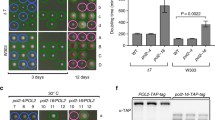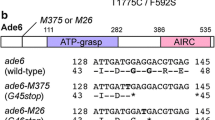Abstract
Prp20/Srm1, a homolog of the mammalian protein RCC1 in Saccharomyces cerevisiae, binds to double-stranded DNA (dsDNA) through a multicomponent complex in vitro. This dsDNA-binding capability of the Prp20 complex has been shown to be cell-cycle dependent; affinity for dsDNA is lost during DNA replication. By analyzing a number of temperature sensitive (ts) prp20 alleles produced in vivo and in vitro, as well as site-directed mutations in highly conserved positions in the imperfect repeats that make up the protein, we have determined a relationship between the residues at these positions, cell viability, and the dsDNA-binding abilities of the Prp20 complex. These data reveal that the essential residues for Prp20 function are located mainly in the second and the third repeats at the amino-terminus and the last two repeats, the seventh and eighth, at the carboxyl-terminus of Prp20. Carboxyl-terminal mutations in Prp20 differ from amino-terminal mutations in showing loss of dsDNA binding: their conditional lethal phenotype and the loss of dsDNA binding affinity are both suppressible by overproduction of Gsp1, a GTP-binding constituent of the Prp20 complex, homologous to the mammalian protein TC4/Ran. Although wild-type Prp20 does not bind to dsDNA on its own, two mutations in conserved residues were found that caused the isolated protein to bind dsDNA. These data imply that, in situ, the other components of the Prp20 complex regulate the conformation of Prp20 and thus its affinity for dsDNA. Gsp1 not only influences the dsDNA-binding ability of Prp20 but it also regulates other essential function(s) of the Prp20 complex. Overproduction of Gsp1 also suppresses the lethality of two conditional mutations in the penultimate carboxyl-terminal repeat of Prp20, even though these mutations do not eliminate the dsDNA binding activity of the Prp20 complex. Other site-directed mutants reveal that internal and carboxyl-terminal regions of Prp20 that lack homology to RCC1 are dispensable for dsDNA binding and growth.
Similar content being viewed by others
References
Aebi M, Clark MW, Vijayraghavan U, Abelson J (1990) A yeast mutant, PRP20, altered in mRNA metabolism and maintenance of the nuclear structure, is defective in a gene homologous to the human gene RCC1 which is involved in the control of chromosome condensation. Mol Gen Genet 224:72–80
Amberg DC, Fleischmann M, Stagljar I, Cole CN, Aebi M (1993) Nuclear PRP20 protein is required for mRNA export. EMBO J 12:233–241
Belhumeur P, Lee A, Tam R, DiPaolo T, Fortin N, Clark MW (1993) GSP1 and GSP2, genetic suppressors of the prp20-1 mutant in Saccharomyces cerevisiae: GTP-binding proteins involved in the maintenance of nuclear organization. Mol Cell Biol 13:2152–2161
Bischoff FR, Ponstingl H (1991a) Catalysis of guanine nucleotide exchange on RAN by the mitotic regulator RCC1. Nature 354:80–82
Bischoff FR, Ponstingl H (1991b) Mitotic regulator protein RCC1 is complexed with a nuclear ras-related polypeptide. Proc Natl Acad Sci USA 88:10830–10834
Boeke JD, LaCroute F, Fink GR (1984) A positive selection for mutants lacking orotidine-5′-phosphate decarboxylase activity in yeast: 5-fluoro-orotic acid resistance. Mol Gen Genet 197:345–346
Clark KL, Sprague GF Jr (1989) Yeast pheromone response pathway: characterization of a suppressor that restores mating to receptorless mutants. Mol Cell Biol 9:2682–2694
Clark KL, Ohtsubo M, Nishimoto T, Goebl M, Sprague GF JR (1991) The yeast SRM1 protein and human RCC1 protein share analogous functions. Cell Regul 2:781–792
Dasso M (1993) RCC1 in the cell cycle: the regulator of chromosome condensation takes on new roles. TIBS 18:96–101
Dasso M, Nishitani H, Kornbluth S, Nishimito T, Newport J (1992) RCC1, a regulator of mitosis, is essential for DNA replication. Mol Cell Biol 12:3337–3345
Drivas GT, Shih A, Coutavas E, Rush MG, D'Eustachio P (1990) Characterization of four novel ras-like genes expressed in a human teratocarcinoma cell line. Mol cell Biol 10: 1793–1798
Fleischmann M, Clark MW, Forrester W, Wickens M, Nishimoto T, Aebi M (1991) Analysis of yeast prp20 mutations and functional complementation by the human homologue RCC1, a protein involved in the control of chromosome condensation. Mol Gen Genet 227:417–423
Forrester W, Stutz F, Rosbash M, Wickens M (1992) Defects in mRNA 3′-end formation, transcription initiation, and mRNA transport associated with the yeast mutation prp20: possible coupling of mRNA processing and chromatin structure. Genes Dev 6:1914–1926
Frasch M (1991) The maternally expressed Drosophila gene encoding the chromatin-binding protein BJ1 is a homolog of the vertebrate gene Regulator of Chromatin Condensation, RCC1. EMBO J 10:1225–1236
Jong AYS, Aebersold R, Campbell JL (1985) Multiple species of single-stranded nucleic acid-binding proteins in Saccharomyces cerevisiae. J Biol Chem 260:16367–16374
Hill JE, Myers AM, Koerner TJ Tzagoloff A (1986) Yeast/E. coli shuttle vectors with multiple unique restriction sites. Yeast 2:163–167
Kadowaki T, Goldfarb D, Spitz LM, Tartakoff AM, Ohno M (1993) Regulation of RNA processing and transport by a nuclear guanine nucleotide release protein and members of the Ras Superfamily. EMBO J 12:2929–2937
Kai R, Ohtsubo M, Sekiguchi M, Nishimoto T (1986) Molecular cloning of a human gene that regulates chromosome condensation is essential for cell proliferation. Mol Cell Biol 6:2027–2032
Kunkel TD, Roberts JD, Zakor RA (1987) Rapid and efficient site-specific mutagenesis without phenotypic selection. Methods Enzymol 154:367–382
Laemmli UK (1970) Cleavage of structural proteins during the assembly of the head of bacteriophage T4. Nature 227:680–685
Lee A, Tam R, Belhumeur P, DiPaolo T, Clark MW (1993) Prp20, the Saccharomyces cerevisiae homolog of the regulator of chromosome condensation, RCC1, interacts with double-stranded DNA through a multi-component complex containing GTP-binding proteins. J Cell Sci 106:287–298
Matsumoto T, Beach D (1991) Premature initiation of mitosis in yeast lacking RCC1 or an interacting GTPase. Cell 66:347–360
Nagai K, Thogersen C (1987) Synthesis and sequence-specific proteolysis of hybrid proteins produced in E. coli. Methods Enzymol 153:461–481
Nishitani H, Kobayashi H, Ohtsubo M, Nishimoto T (1990) Cloning of Xenopus RCC1 cDNA, a homolog of the human RCC1 gene: complementation of tsBN2 mutation and identification of the product. J Biochem 107:228–235
Nishitani H, Ohtsubo M, Yamashita K, Lida H, Pines J, Yasudo H, Shibata Y, Hunter T, Nishimoto T (1991) Loss of RCC1, a nuclear DNA-binding protein, uncouples the completion of DNA replication from the activation of cdc2 protein kinase and mitosis. EMBO J 10:1555–1564
Ohtsubo M, Kai R, Furuno N, Sekiguchi T Sekiguchi M, Hayashida H, Kuma KI, Miyata T, Fukushige S, Murotsu T, Matsubara K, Nishimoto T (1987) Isolation and characterization of the active cDNA of the human cell cycle gene (RCC1) involved in the regulation of onset of chromosome condensation. Genes Dev 1:585–593
Ohtsubo M, Okazaki H, Nishimoto T (1989) The RCC1 protein, a regulator for the onset of chromosome condensation locates in the nucleus and binds to DNA. J Cell Biol 109:1389–1397
Ohtsubo M, Yoshida T, Seino H, Nishitani H, Clark KL, Sprague GF, Jr Frasch M, Nishimoto T (1991) Mutation of the hamster cell cycle gene RCC1 is complemented by the homologous gene of Drosophila and S. cerevisiae. EMBO J 10:1265–1273
Orr-Weaver TC, Szostak J, Rothstein RJ (1981) Yeast transformation: a model system for the study of recombination. Proc Natl Acad Sci USA 78:6354–6358
Raymond CK, O'Hara PJ, Eichinger G, Rotherman JH, Stevens TH (1990) Molecular analysis of the VPS3 gene and the role of its product in vacuolar protein sorting and vacuolar segregation during the cell cycle. J Cell Biol 111:877–892
Ren M, Drivas G, D'Eustachio P, Rush MG (1993) Ran/TC4: A small nuclear GTP-binding protein that regulates DNA synthesis. J Cell Biol 120:313–323
Sazer S, Nurse P (1992) the dcd1-1 is mutant in a fission yeast RCC1-like gene prevents chromosome decondensation at mitotic exit. Mol Cell Biol [Supp] 3:189a
Seino H, Hisamoto N, Uzawa S, Sekiguchi T, Nishimoto T (1992) DNA-binding domain of RCC1 proteins is not essential for coupling mitosis with DNA replication. J Cell Sci 102:393–400
Sherman F, Fink GR, Hicks JB (1986) Methods in yeast genetics. Cold Spring Harbor Laboratory Press, Cold Spring Harbor, New York
Sikorski RS Hieter P (1989) A system of shuttle vectors and yeast host strains designed for efficient manipulation of DNA in Saccharomyces cerevisiae. Genetics 122:19–27
Uchida S, Sekiguchi T, Nishitani H, Miyauchi K, Ohtsubo M, Nishimoto T (1990) Premature chromosome condensation is induced by a point mutation in the hamster RCC1 gene. Mol Cell Biol 10:577–584
Author information
Authors and Affiliations
Additional information
ommunicated by C. Hollenberg
Rights and permissions
About this article
Cite this article
Lee, A., Clark, K.L., Fleischmann, M. et al. Site-directed mutagenesis of the yeast PRP20/1SRM1 gene reveals distinct activity domains in the protein product. Molec. Gen. Genet. 245, 32–44 (1994). https://doi.org/10.1007/BF00279748
Received:
Accepted:
Issue Date:
DOI: https://doi.org/10.1007/BF00279748




